Day 38-39 – February 11-12
In my previous blog, I inquired as to the physics behind the moisture from the Pacific dumping on the eastern side of the Andes rather than the western thus forming the large South American Pacific coast desert. I received the following from Jim Schaefer in my office:
=====================
One reason is that the high atmospheric pressure in this region over the Andes can cause dry, cold air from the upper altitudes to compress and come down to earth. This dry air has almost no water vapor so it can be easily heated by the sun, causing high ground temperatures with very low humidity.
Another reason that the Atacama doesn't get enough rainfall is because of a phenomenon called rainshadow. The warm, moist tropical air that blows on the tradewinds from the east, which douse the South American rainforest, get hung-up on the east side of the Andes.
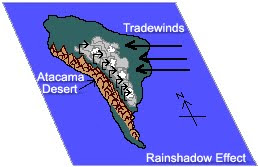
The mountains are so high in altitude that the air cools, condenses and rains (or snows) on the mountains. As the air descends the other side of the mountain range it warms, holding in its moisture preventing rain from falling on to the ground below.
This is one of the reasons why the Amazon basin and river are the largest anywhere in the world. The mountains that cause the Amazon to be the largest river from collecting all the rainfall are also responsible for preventing the Atacama from ever receiving any rainfall. The driest and one of the wettest places in the world are right next to each other!
The rain shadow on the leeward side of the Chilean Coast Range, as well as a coastal inversion layer created by the cold offshore Humboldt Current, keep this over 20 million-year-old desert 50 times drier than California's Death Valley.
=====================
South of Abancay, Peru to Cuzco, Peru
We left our idyllic Italian-Alpine Chateau . . .
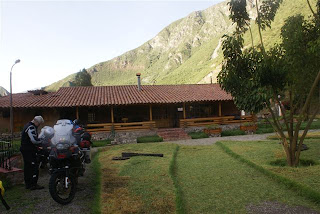

. . . heading through a steep river valley on our way to Cuzco, Peru.
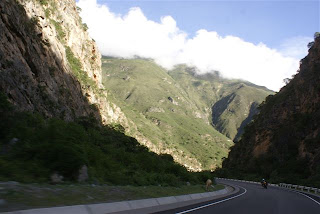
And encountered small streams rushing over the road . . .
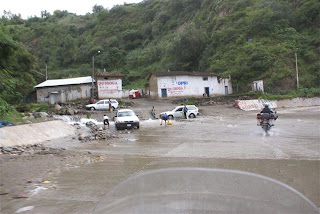
. . . and small villages.
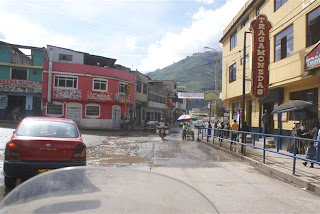
We climbed over 13,000 feet and looked down on the clouds . . .
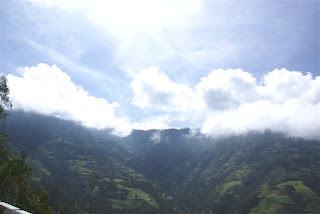
. . . through rugged mountainous terrain on a switchback road . . .
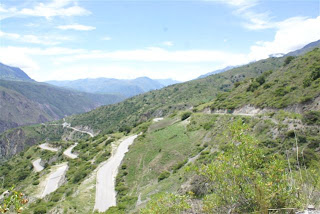
Because of the recent rains the river along our route to Cuzco was running red . . .
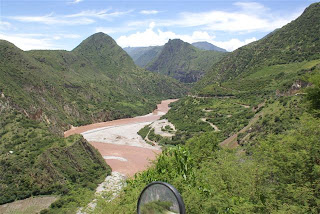
There wasn’t much room for the road along this 10 mile stretch of canyon . . .
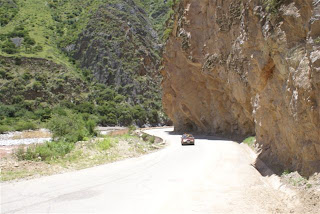
In this narrow canyon assisted by the recent rains the river clearly won over the road. They were attempting to reroute the river using front end loaders and large tracked backhoes.
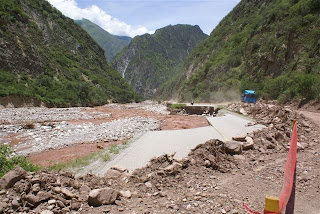
and left Cuzco without its lifeline for the two weeks it took to patch an alternative route – but the newly patched route made for very rough going, particularly for the big trucks.
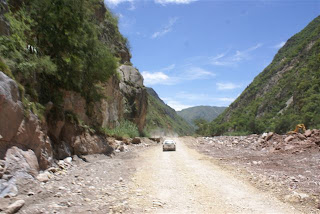
Supporting the roads through this lightly populated rugged terrain is particularly difficult for a small country like Peru. In a struggle between Mother Nature and a caterpillar tractor, Mother Nature wins out whenever she wants. The cliffs and steep slopes leading down to the road provide an endless supply of large boulders which constantly need to be removed by tractors.
At a number of points along our way the traffic is stopped - - Helge is talked into some sort of mystery dish by this cute little girl (watch out for Montezuma’s revenge)!
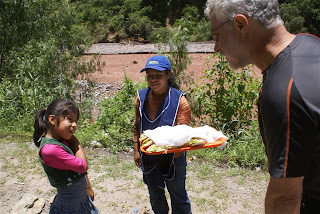
As we near Cuzco we are rewarded with a beautiful landscape of a neat patchwork of farms . . .
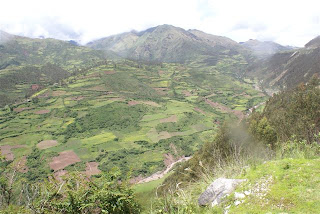
In steep areas they often rely on terraced farming and even pastures – in proportion to the land cultivated, this requires a significant amount of time building and maintaining retaining walls. It’s difficult to compete with the farms that have cash crops – like in Ohio.
We beat the rain into Cuzco and were able to do some sight seeing.
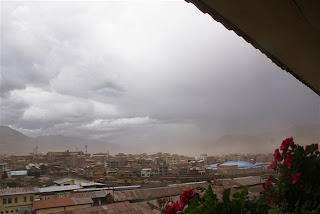
Cuzco was formerly the capital of Peru and there are a lot of impressive government buildings and churches – some of which have been built on the foundations of Incan temples.
Our goal had been to go to Machu Picchu but the significant rains created a landslide shutting down the railroad and other access roads. We attempted to rent a helicopter to take us there, but the government has set Machu Picchu off limits.
So the next day we toured some of the archeological sites of Cuzco – next year’s trip will include the much more impressive Machu Picchu.
Cuzco is definitely a tourist town but now with Machu Picchu off limits it was virtually empty and the town is feeling the effects of a bad economy. We made sure to empty our motorcycles of temptations before parking them in the garage. I was amazed as we entered Cuzco that it had the stamp of a tourist town – a bungee jumping apparatus, suspended between four hills with a basket high above us.
We first went to a temple on the outskirts of town, constructed in a terraced fashion, with huge stones – one of which weighed over 120 tons. The archeological site encompassed approximately 300 acres. The main temple was built with irregularly shaped stones that fit intimately together.
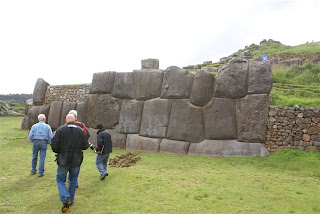
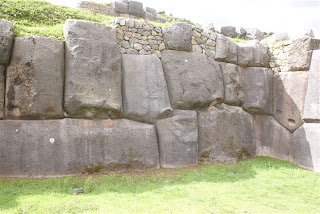
The stones were harvested from a quarry 10-20 miles away from the site in the same manner as the pyramids.
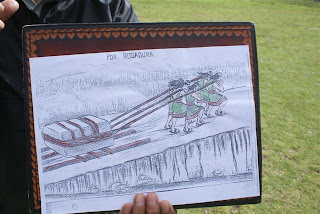
He claimed that after they set a stone they would make a wooden model of the next stone to be placed – using the model to cut the next piece. The stones are limestone formed in the Paleozoic era - - in this stone you can see fossils of marine animals.
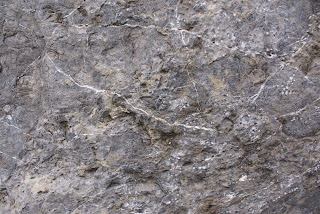
Unfortunately, preserving these ruins is a recent activity. This temple had been used as a stone quarry for many years – used to build the Spanish churches – and all that was left behind were the stones too large to move.

The recent torrential rains have been undermining the temple structure - - so they have covered the vulnerable areas with tarps to reduce the possibility of erosion and mudslides . . .
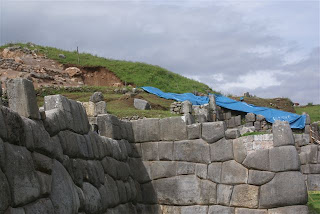
You can see to the left of the tarp a slide which occurred in the last month or two.
This same erosion has been occurring throughout Cuzco - - here you can see their attempt to quell the mudslides with the use of blue tarpaulins . . .
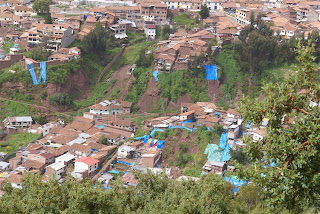
There were lots of Peruvians at the archeological site including college students on break. In Peru, the children go 2 years to kindergarten, 5 years elementary school and 5 years of college (somewhat equivalent to our high school). Upon graduation they will receive a minimum wage of the equivalent of US$200 per month – and a college professor only makes about 2.5 times that amount. In parts of Asia a living wage is perhaps half that amount.
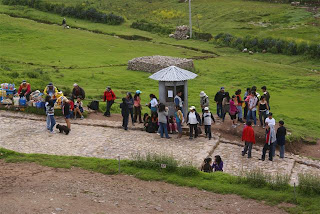
Prosperous looking mothers and children . . .
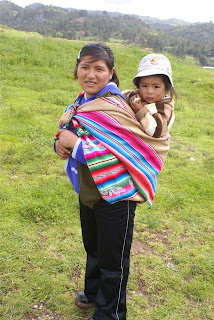
And less prosperous ones . . .
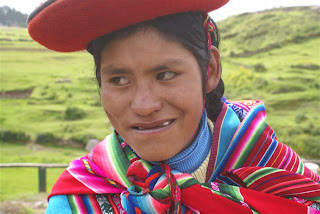
This 15 year had a baby on her back and made her living from allowing tourists to take pictures of her and her llama . . .
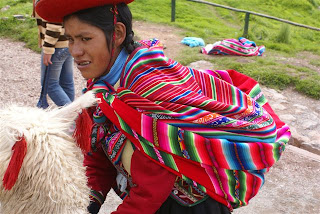
It looked like a tragic situation and I felt sorry for her.
We went to what was billed as a weaving factory – the factory part turned out to be largely a sham with two guys running a Singer weaving machine.
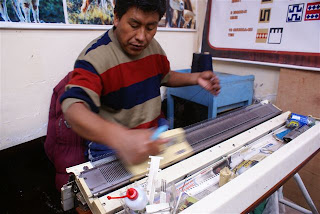
It was a great store for llama and vicuna clothing complete with live animals parked outside – some scruffy looking . . .
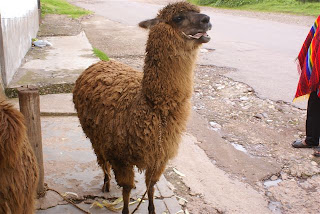
And some elegant and feminine looking . . .
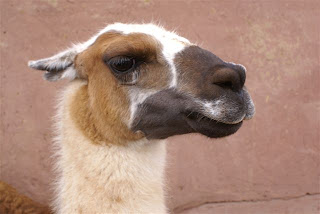
But as you can see they weren’t overgenerous with their affection . . .
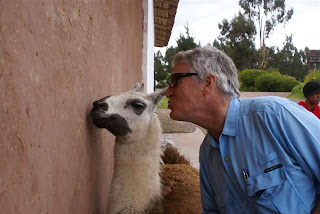
Unlike their Asian cousins . . .
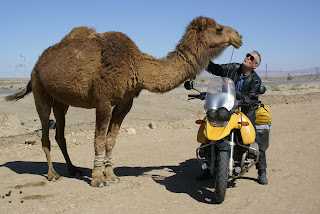
I was disappointed that our guide did not know more about early Incan history. The reasons behind the success of the Incans are still a little confusing to me. According to the guide the Incan culture began to emerge in 1200 BC and reached its apex 200-300 years later. It came to an end with the arrival of the Spanish in 1528 - at that point the population of Cuzco was about 100,000 (it is now 400,000). I believe the Incans generally have the same genetics as our American Indians, yet why were they able to achieve such a large unified empire? At the height of their empire, the Inca territory stretched from what is now the border of Colombia and Ecuador to central Chile – a distance of over 3,400 miles. The Inca people, who numbered only about 100,000, ruled from 10 to 12 million people from at least 86 ethnic groups with their own languages, traditions and religious beliefs.
What was the “secret sauce” that enabled the Incas to build an empire while the American Indians had only tiny tribes by comparison?
- Was it the presence of forceful leadership? – There were perhaps 9 Incan chiefs during their period of dominance. Following the death of the last Incan leader, power was divided between his two sons – one to the north and one to the south. They ruled for 9 years prior to the arrival of the Spanish.
- Or were they primarily farmers and tied to the land, and that created the need for bureaucracy and government?
- Or did they develop some clever hybrid plant that made them more efficient farmers, and that enabled them to spread their culture?
- Or perhaps they were just good warriors, like Genghis Kahn.
- Or maybe it was that they conducted human sacrifices and were able to gain a foothold by fear, selective sacrifice criteria, and with a complicated pantheon of greater and lesser gods (just kidding).
We did not really get a clear picture of their “product plus” that made the Incas so effective. Leadership is clearly an important aspect. Consider these recent emerging leaders, Vincente Fox and Felipe Calderon in Mexico, Nobel laureate Oscar Arias in Costa Rica, and Alvaro Uribe in Colombia. These leaders all effectively changed the direction of their respective countries – they each have a superior education, a great love of their homeland, and significant organizational experience before assuming their roles – either in business, in law, or in government. These leaders had many global opportunities, but they devoted their talent and their lives to bettering their country. Fox, Calderon, and Uribe have degrees from Harvard, while Arias took his advanced degree from the London School of Economics.
In contrast, in the failed states such as Nicaragua and Venezuela, the leadership has been dominated by people with little education, little administrative experience, and a socialist agenda. Daniel Ortega in Nicaragua barely finished high school, never held a university degree and had no experience in business or government when he joined the underground movement that helped overthrow Nicaragua’s dictator in 1979. Hugo Chavez in Colombia had more education, but advocates socialism, price controls, and strict control of the media. Perhaps the most classic case is Morales in Bolivia – who started out as a llama herder. He advocates socialism and has been ineffective at revitalizing Bolivia. Charlie Wilson wanted education for Afghanistan as a way to ensure a lasting peace. He and George Crile were clearly onto something.
As we elect a leader for Cuyahoga County, we need to be careful to pick someone who is skilled at choosing good lieutenants to reform the important social welfare, health, economic development and capital project aspects of county government. On this short trip we have dramatically seen what works and what doesn’t.
Tomorrow we will head for the Bolivian border.
One reason is that the high atmospheric pressure in this region over the Andes can cause dry, cold air from the upper altitudes to compress and come down to earth. This dry air has almost no water vapor so it can be easily heated by the sun, causing high ground temperatures with very low humidity.
Another reason that the Atacama doesn't get enough rainfall is because of a phenomenon called rainshadow. The warm, moist tropical air that blows on the tradewinds from the east, which douse the South American rainforest, get hung-up on the east side of the Andes.

The mountains are so high in altitude that the air cools, condenses and rains (or snows) on the mountains. As the air descends the other side of the mountain range it warms, holding in its moisture preventing rain from falling on to the ground below.
This is one of the reasons why the Amazon basin and river are the largest anywhere in the world. The mountains that cause the Amazon to be the largest river from collecting all the rainfall are also responsible for preventing the Atacama from ever receiving any rainfall. The driest and one of the wettest places in the world are right next to each other!
The rain shadow on the leeward side of the Chilean Coast Range, as well as a coastal inversion layer created by the cold offshore Humboldt Current, keep this over 20 million-year-old desert 50 times drier than California's Death Valley.
=====================
South of Abancay, Peru to Cuzco, Peru
We left our idyllic Italian-Alpine Chateau . . .
. . . heading through a steep river valley on our way to Cuzco, Peru.
And encountered small streams rushing over the road . . .
. . . and small villages.
We climbed over 13,000 feet and looked down on the clouds . . .
. . . through rugged mountainous terrain on a switchback road . . .
Because of the recent rains the river along our route to Cuzco was running red . . .
There wasn’t much room for the road along this 10 mile stretch of canyon . . .
In this narrow canyon assisted by the recent rains the river clearly won over the road. They were attempting to reroute the river using front end loaders and large tracked backhoes.
and left Cuzco without its lifeline for the two weeks it took to patch an alternative route – but the newly patched route made for very rough going, particularly for the big trucks.
Supporting the roads through this lightly populated rugged terrain is particularly difficult for a small country like Peru. In a struggle between Mother Nature and a caterpillar tractor, Mother Nature wins out whenever she wants. The cliffs and steep slopes leading down to the road provide an endless supply of large boulders which constantly need to be removed by tractors.
At a number of points along our way the traffic is stopped - - Helge is talked into some sort of mystery dish by this cute little girl (watch out for Montezuma’s revenge)!
As we near Cuzco we are rewarded with a beautiful landscape of a neat patchwork of farms . . .
In steep areas they often rely on terraced farming and even pastures – in proportion to the land cultivated, this requires a significant amount of time building and maintaining retaining walls. It’s difficult to compete with the farms that have cash crops – like in Ohio.
We beat the rain into Cuzco and were able to do some sight seeing.
Cuzco was formerly the capital of Peru and there are a lot of impressive government buildings and churches – some of which have been built on the foundations of Incan temples.
Our goal had been to go to Machu Picchu but the significant rains created a landslide shutting down the railroad and other access roads. We attempted to rent a helicopter to take us there, but the government has set Machu Picchu off limits.
So the next day we toured some of the archeological sites of Cuzco – next year’s trip will include the much more impressive Machu Picchu.
Cuzco is definitely a tourist town but now with Machu Picchu off limits it was virtually empty and the town is feeling the effects of a bad economy. We made sure to empty our motorcycles of temptations before parking them in the garage. I was amazed as we entered Cuzco that it had the stamp of a tourist town – a bungee jumping apparatus, suspended between four hills with a basket high above us.
We first went to a temple on the outskirts of town, constructed in a terraced fashion, with huge stones – one of which weighed over 120 tons. The archeological site encompassed approximately 300 acres. The main temple was built with irregularly shaped stones that fit intimately together.
The stones were harvested from a quarry 10-20 miles away from the site in the same manner as the pyramids.
He claimed that after they set a stone they would make a wooden model of the next stone to be placed – using the model to cut the next piece. The stones are limestone formed in the Paleozoic era - - in this stone you can see fossils of marine animals.
Unfortunately, preserving these ruins is a recent activity. This temple had been used as a stone quarry for many years – used to build the Spanish churches – and all that was left behind were the stones too large to move.
The recent torrential rains have been undermining the temple structure - - so they have covered the vulnerable areas with tarps to reduce the possibility of erosion and mudslides . . .
You can see to the left of the tarp a slide which occurred in the last month or two.
This same erosion has been occurring throughout Cuzco - - here you can see their attempt to quell the mudslides with the use of blue tarpaulins . . .
There were lots of Peruvians at the archeological site including college students on break. In Peru, the children go 2 years to kindergarten, 5 years elementary school and 5 years of college (somewhat equivalent to our high school). Upon graduation they will receive a minimum wage of the equivalent of US$200 per month – and a college professor only makes about 2.5 times that amount. In parts of Asia a living wage is perhaps half that amount.
Prosperous looking mothers and children . . .
And less prosperous ones . . .
This 15 year had a baby on her back and made her living from allowing tourists to take pictures of her and her llama . . .
It looked like a tragic situation and I felt sorry for her.
We went to what was billed as a weaving factory – the factory part turned out to be largely a sham with two guys running a Singer weaving machine.
It was a great store for llama and vicuna clothing complete with live animals parked outside – some scruffy looking . . .
And some elegant and feminine looking . . .
But as you can see they weren’t overgenerous with their affection . . .
Unlike their Asian cousins . . .
I was disappointed that our guide did not know more about early Incan history. The reasons behind the success of the Incans are still a little confusing to me. According to the guide the Incan culture began to emerge in 1200 BC and reached its apex 200-300 years later. It came to an end with the arrival of the Spanish in 1528 - at that point the population of Cuzco was about 100,000 (it is now 400,000). I believe the Incans generally have the same genetics as our American Indians, yet why were they able to achieve such a large unified empire? At the height of their empire, the Inca territory stretched from what is now the border of Colombia and Ecuador to central Chile – a distance of over 3,400 miles. The Inca people, who numbered only about 100,000, ruled from 10 to 12 million people from at least 86 ethnic groups with their own languages, traditions and religious beliefs.
What was the “secret sauce” that enabled the Incas to build an empire while the American Indians had only tiny tribes by comparison?
- Was it the presence of forceful leadership? – There were perhaps 9 Incan chiefs during their period of dominance. Following the death of the last Incan leader, power was divided between his two sons – one to the north and one to the south. They ruled for 9 years prior to the arrival of the Spanish.
- Or were they primarily farmers and tied to the land, and that created the need for bureaucracy and government?
- Or did they develop some clever hybrid plant that made them more efficient farmers, and that enabled them to spread their culture?
- Or perhaps they were just good warriors, like Genghis Kahn.
- Or maybe it was that they conducted human sacrifices and were able to gain a foothold by fear, selective sacrifice criteria, and with a complicated pantheon of greater and lesser gods (just kidding).
We did not really get a clear picture of their “product plus” that made the Incas so effective. Leadership is clearly an important aspect. Consider these recent emerging leaders, Vincente Fox and Felipe Calderon in Mexico, Nobel laureate Oscar Arias in Costa Rica, and Alvaro Uribe in Colombia. These leaders all effectively changed the direction of their respective countries – they each have a superior education, a great love of their homeland, and significant organizational experience before assuming their roles – either in business, in law, or in government. These leaders had many global opportunities, but they devoted their talent and their lives to bettering their country. Fox, Calderon, and Uribe have degrees from Harvard, while Arias took his advanced degree from the London School of Economics.
In contrast, in the failed states such as Nicaragua and Venezuela, the leadership has been dominated by people with little education, little administrative experience, and a socialist agenda. Daniel Ortega in Nicaragua barely finished high school, never held a university degree and had no experience in business or government when he joined the underground movement that helped overthrow Nicaragua’s dictator in 1979. Hugo Chavez in Colombia had more education, but advocates socialism, price controls, and strict control of the media. Perhaps the most classic case is Morales in Bolivia – who started out as a llama herder. He advocates socialism and has been ineffective at revitalizing Bolivia. Charlie Wilson wanted education for Afghanistan as a way to ensure a lasting peace. He and George Crile were clearly onto something.
As we elect a leader for Cuyahoga County, we need to be careful to pick someone who is skilled at choosing good lieutenants to reform the important social welfare, health, economic development and capital project aspects of county government. On this short trip we have dramatically seen what works and what doesn’t.
Tomorrow we will head for the Bolivian border.
Back to Top

Add A Comment